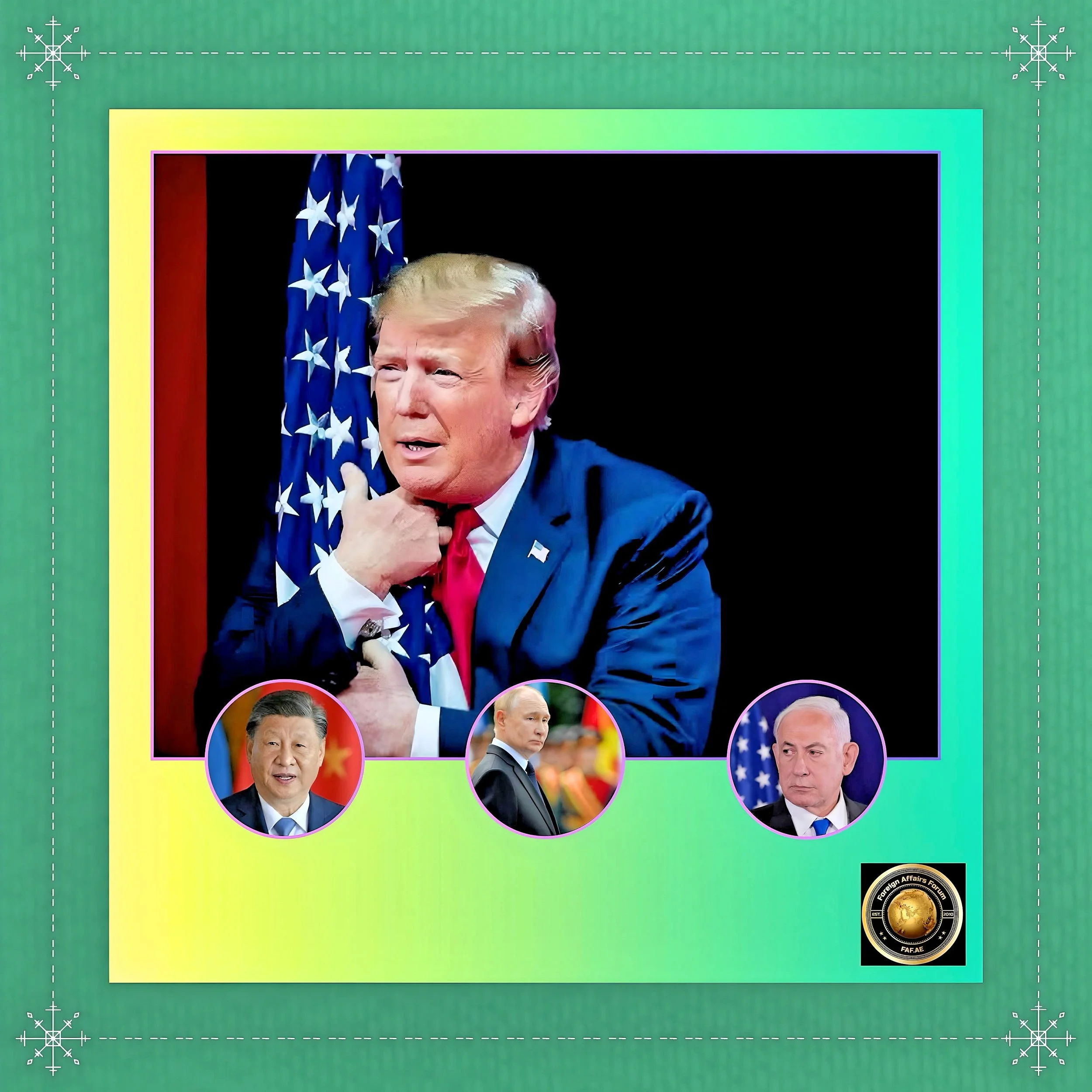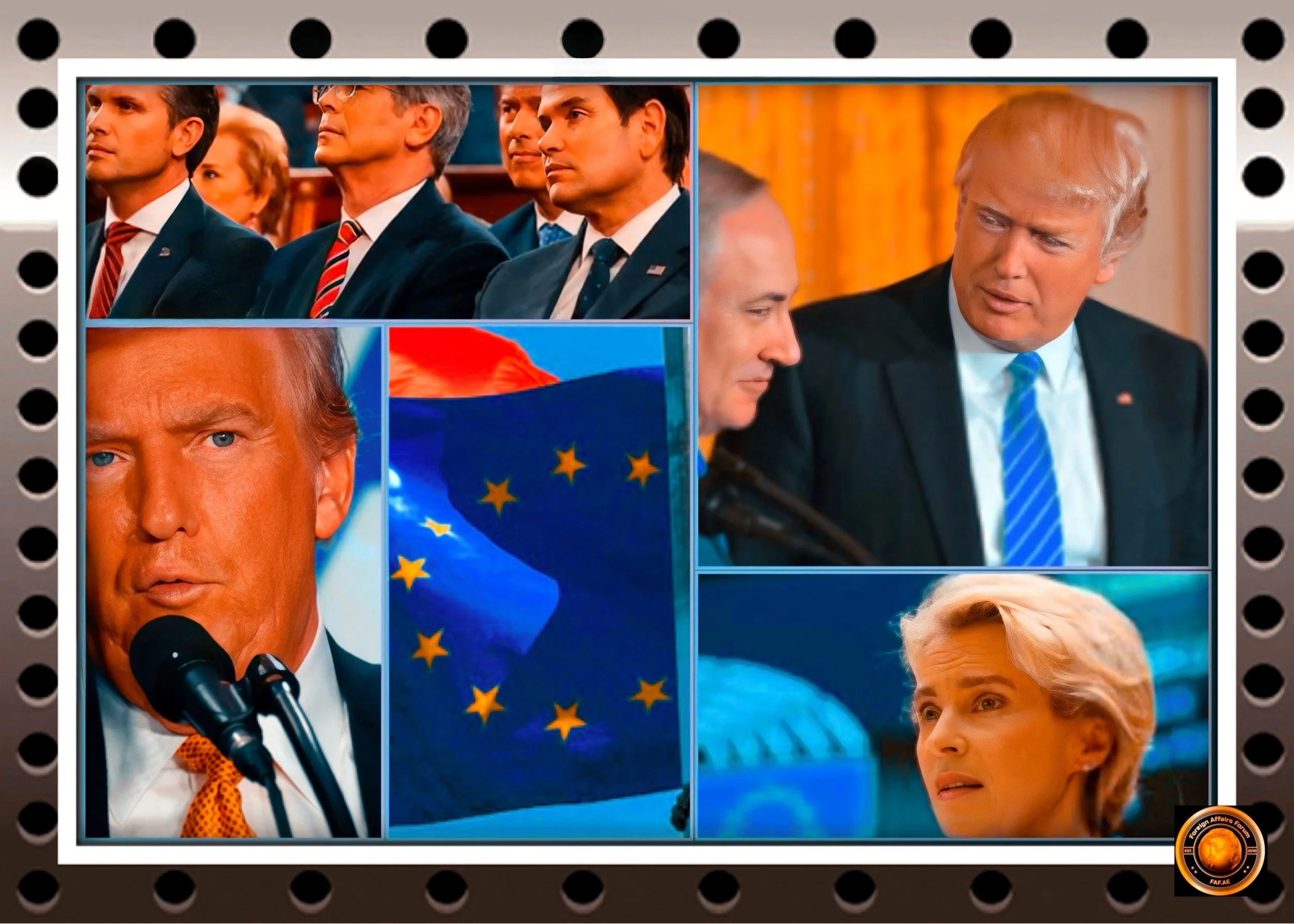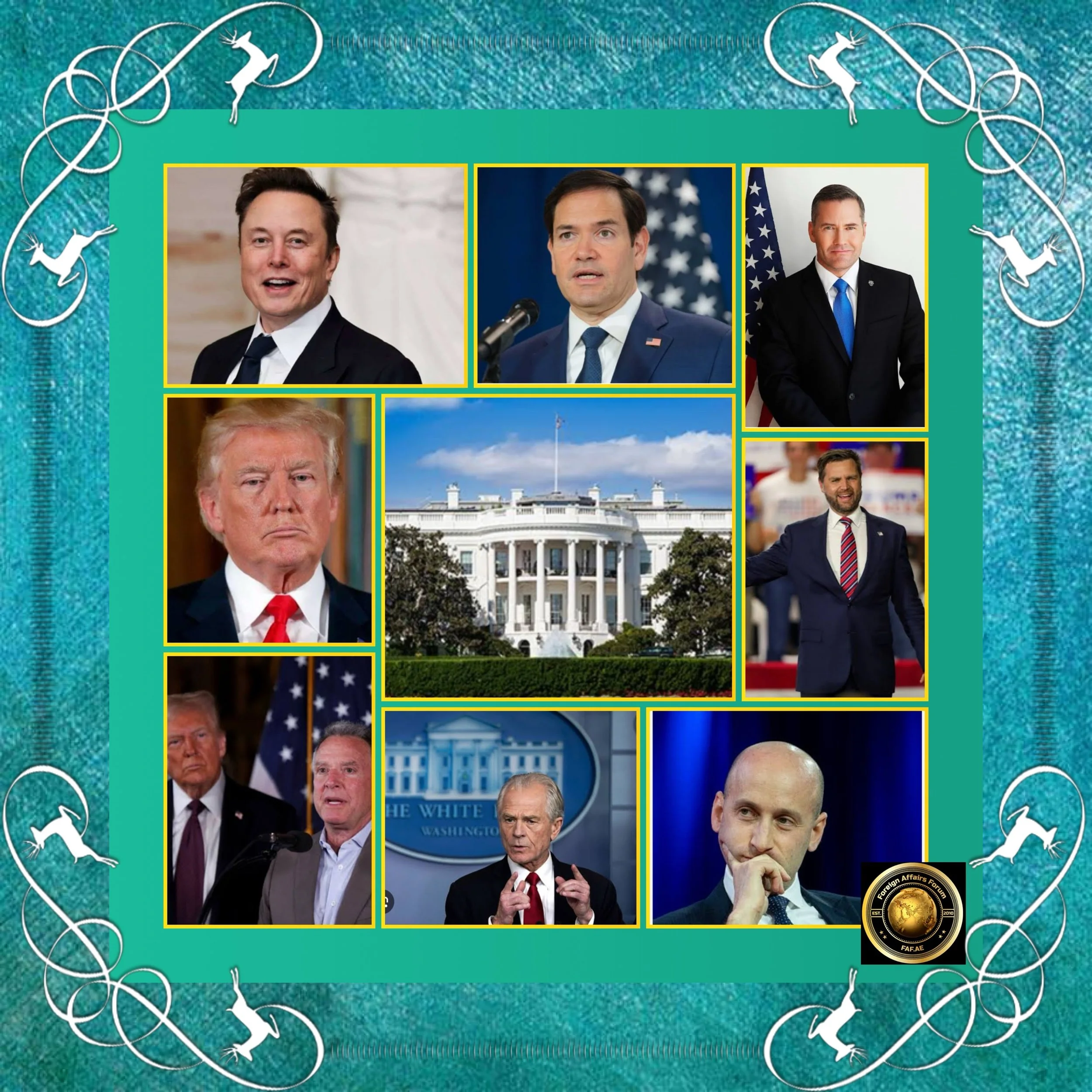Trump’s First 100 Days on the Global Stage: A Watershed Moment in American Foreign Policy
Introduction
As President Donald Trump approaches the 100-day mark of his second term on April 30, his administration has already dramatically reshaped America’s role on the global stage.
Through an unprecedented flurry of executive actions, controversial diplomatic maneuvers, and a sweeping trade war, Trump has upended traditional alliances, challenged international norms, and created what many analysts describe as calculated chaos.
FAF analyzes the global impact of Trump’s first 100 days, examining how his “America First” agenda has manifested in policy decisions that have sent shockwaves through international markets, diplomatic circles, and geopolitical power structures.
The Shock and Awe Strategy
Executive Actions and Policy Blitz
Trump’s second term began with what one senior administration official described as a strategy dependent on “his ability to shock you.”
In stark contrast to traditional presidential transitions, Trump has employed an overwhelming barrage of executive orders and policy changes that have left even seasoned observers struggling to keep pace.
Unprecedented Use of Executive Authority
As of late April, the administration had implemented 137 executive orders, 26 of which were signed in the first days of his term. This is more than three times the number issued by former President Biden during the same period and substantially exceeds his first-term record.
These orders have targeted everything from federal bureaucracy to international trade agreements, and more than 80 lawsuits have already challenged his directives on immigration, gender and diversity, and climate change.
The Department of Government Efficiency Experiment
One of Trump’s most talked-about initiatives has been the establishment of the Department of Government Efficiency (DOGE), led by billionaire Elon Musk.
This unprecedented appointment of a private sector titan to restructure federal agencies has been praised and criticized.
While Trump supporters have applauded the effort to streamline government, critics have pointed to the significant disruption in federal services and the removal of more than one hundred thousand federal workers in just three months.
However, Musk recently announced a reduction in his DOGE involvement, stating that his job was “mostly done” and would cut his time allocation significantly from May onward to refocus on Tesla.
Trump defended Musk against critics, stating, “He didn’t need to do this. He did it,” suggesting that Musk’s government service unfairly influenced Tesla’s recent business challenges.
Global Economic Disruption
The Trade War Escalates
Perhaps no single action has had more immediate global impact than Trump’s dramatic escalation of tariffs against major trading partners, representing the most significant disruption to international trade in decades.
The “Liberation Day” Tariff Announcement
On April 2, 2025, Trump declared a blanket 10% tariff on all imports effective April 5, with additional country-specific tariffs commencing on April 9.
Most notably, imports from China now face a staggering 104-145% tariff rate, representing a dramatic escalation in the U.S.-China economic rivalry.
Trump’s administration also released a list of 57 countries, territories, and trading blocs subject to increased tariffs beyond the baseline 10% rate.
Market Chaos and Economic Fallout
The market reaction was swift and severe. The announcement triggered the worst two-day loss in U.S. stock market history, with $6.6 trillion in value erased before markets closed for the weekend.
Overall, the S&P 500 index has declined 8.5% since Inauguration Day, and Bloomberg reported that approximately $10 trillion in global equity value was wiped out in just three days following the tariff announcements.
This economic volatility has put Trump in a delicate political position.
While his core supporters have embraced the aggressive trade stance as delivering on campaign promises, the market reaction has prompted concerns even among Republican lawmakers about potential electoral consequences.
Responding to these concerns, Trump announced a 90-day pause on higher rates for specific countries, conspicuously excluding China.
Realigning Global Alliances
Disruption as a Diplomatic Strategy
Trump’s approach to international relations has represented a significant departure from conventional American diplomacy, characterized by unpredictability and transactional relationships that have realigned U.S. relationships worldwide.
The Putin-Ukraine Equation
Trump presented Ukraine with a “final offer” peace framework that includes tangible gains for Russia, and alarming European allies were sidelined from ceasefire discussions.
The administration also removed Lt. Gen. Keith Kellogg, its envoy for Ukraine, after his views on Kyiv diverged from those of the president and vice president.
This approach reflects what some analysts have described as a fundamental shift in U.S. foreign policy strategy.
While previous administrations sought stability through clear diplomatic channels and predictable responses, Trump believes that unpredictability can be leveraged as a strategic asset.
As one analysis noted, “If the United States acts powerfully and in occasionally unpredictable ways, countries pull back to fear of conflict with the United States pushes them to limit their behavior.”
New Approaches to Latin America and Immigration
The administration has struck deals with Latin American nations to assist with immigration enforcement, most notably with El Salvador, which has accepted hundreds of deportees from the United States into its prison system without due process.
This arrangement exemplifies Trump’s broader approach to mass deportation, which has mobilized agencies across the federal government, from the IRS to the Postal Service.
These policies have had an immediate impact on international perception of the United States, with Trump’s stringent stance on migrants and tourists significantly reducing visitors to the country.
The administration has also reportedly “snatched foreign students off the streets and stripped their visas for engaging in a speech he dislikes.”
Strained Relationships with Traditional Allies
Traditional alliances have shown signs of significant strain. Trump’s reported remarks about “making Canada the 51st state” have ignited anti-U.S. sentiments in Canada, while European allies, increasingly concerned about being marginalized in global security discussions, are ramping up military capabilities at an unprecedented rate.
The administration has also made provocative statements about potentially taking Greenland by force, seizing control of the Panama Canal, and annexing Canada.
While these may be viewed as rhetorical rather than literal policy positions, they nevertheless represent a dramatic shift in tone that has reshaped how America is perceived globally.
Competing Visions
Internal Battles Over Foreign Policy
The chaotic appearance of Trump’s foreign policy may partially result from competing factions within his administration, representing different strains of Republican foreign policy thought.
The Nationalist-Traditionalist Divide
Foreign policy experts have identified at least two major camps within the administration: a nationalist, protectionist wing focused primarily on China that is “no longer neoconservative,” and a group of “more traditional, uber-hawkish, internationalist Republicans”.
Trump’s own instincts appear to align more with the nationalist faction, but there are ongoing tensions as traditional Republican foreign policy figures attempt to influence the administration’s direction.
These divisions have created visible policy contradictions. For example, Vice President J.D. Vance reportedly made a last-minute plea to delay strikes on Yemeni Houthis that he felt would be “unproductive and wasteful,” before being overruled.
Similarly, National Security Advisor Mike Waltz is reportedly “struggling with the fact that his own views frequently diverge from those of the president”.
Trump’s Growing Autonomy
Unlike his first term, where advisors often succeeded in moderating or redirecting Trump’s impulses, the president appears significantly less constrained by his team in his second term.
This has manifested in sudden personnel decisions, such as the dismissal of several National Security Council staff members after social media personality Laura Loomer convinced Trump they harbored “disloyalty and neoconservative sympathies”.
White House Chief of Staff Susie Wiles summarized this dynamic bluntly: “He had four years to think about what he wanted to do, and now he wants it executed on”.
This greater autonomy has allowed Trump to pursue policies more aligned with his instincts rather than traditional Republican orthodoxy.
Public Perception and Presidential Approval
As Trump approaches the 100-day mark, his approval ratings provide insight into how Americans are responding to his second-term agenda.
Comparative Approval Ratings
Trump’s current approval rating stands at approximately 45-47%, making it the second-lowest for any post-war president at this point in their term.
However, this represents an improvement compared to his first term, when his ratings rarely exceeded 45%.
The partisan divide in these numbers remains stark: 84% of Republicans and Republican-leaning independents approve of Trump’s job performance, compared to just 10% of Democrats and Democratic leaners.
This polarization has been a consistent feature of Trump’s presidency, though the gap is even wider than during his final weeks in office in 2021.
Shifting Approval Trends
There are some signs that Trump’s aggressive policy moves have affected his standing even among supporters.
His approval rating has declined slightly from 53% in December 2024 to 48% in February 2025.
Notably, this drop is concentrated among those with mixed views of Trump, whose approval fell from 77% to 67% during this period, while those with strongly positive or negative perceptions maintained consistent views.
The administration appears aware of these dynamics, planning a rally in Michigan’s Macomb County on April 30 to mark the 100-day milestone and reinforce support in key battleground states.
Trump has limited his travel during his first three months, making this public appearance particularly significant as he seeks to frame the narrative around his early accomplishments.
Conclusion
Assessing the First 100 Days and Future Implications
Donald Trump’s first 100 days in his second term have represented one of the most disruptive periods in modern American foreign policy.
Through an unprecedented use of executive authority, aggressive trade policies, and a diplomacy based on unpredictability, he has reshaped America’s global posture and relationships in ways that will likely have lasting consequences.
A New Global Order or Temporary Disruption?
The fundamental question facing analysts is whether Trump’s approach represents a temporary disruption or the beginning of a more permanent realignment of American foreign policy.
His administration has clearly departed from the bipartisan consensus that guided U.S. international relations for decades, but it remains uncertain whether these changes will outlast his presidency.
The economic impacts of his policies-particularly the sweeping tariffs-have already produced significant volatility in global markets, with potential longer-term effects on inflation, supply chains, and international trade structures.
Similarly, his approach to traditional alliances has strained relationships that took generations to build, potentially altering the global security architecture.
The Path Forward
As Trump moves beyond his first 100 days, several factors will shape the evolution of his foreign policy.
The ongoing tension between competing factions within his administration may produce continued policy inconsistencies.
The economic consequences of his tariffs could either moderate his approach or encourage further economic nationalism.
And reactions from global leaders may either reinforce his belief in the efficacy of unpredictability or encourage more conventional diplomatic approaches.
What is clear is that the traditional tools for analyzing U.S. foreign policy have proven inadequate for understanding the Trump administration’s approach.
As one analyst noted, “it’s so far impossible to define any one Trump Doctrine”.
Instead, his administration appears to be forging a new paradigm-one characterized by disruption, assertiveness, and a fundamental recalculation of American interests on the global stage.
The remainder of Trump’s term will reveal whether this approach ultimately strengthens America’s position in the world or diminishes it.
But there can be little doubt that his first 100 days have already transformed the landscape of global politics in ways few predicted and many are still struggling to understand.






